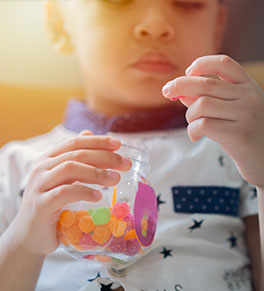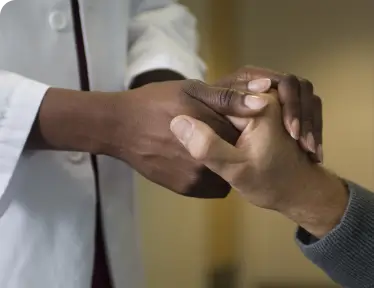Is it candy or medicine? Keeping kids safe from harm

From vitamins to prescription medications and marijuana edibles, U.S. children are at greater risk than ever for accidental overdoses.
In fact, these events are the leading cause of emergency department visits in young kids, according to the U.S. Centers for Disease Control and Prevention.
About 35,000 children are admitted every year after ingesting products intended for adults.
“Many medicines or supplements — especially those in gummy form — can look, smell and even taste like candy,” says UCI Health pediatrician Dr. Pei Lin Chang.
This makes it difficult for young children, and even for some adults, to tell the difference.
“The packaging also is very appealing, so it’s hard for kids, even when they’ve been taught not to touch medications, to resist or take something accidentally because they thought it was a sweet.”
When can children understand?
“Children, 3-year-old and younger, are at highest risk for accidental ingestions in general and also for choking hazards,” says Chang.
Most children develop an understanding of the difference between candy and medicine around four years old. But this is not a reliable gauge for cannabis products that are often packaged to resemble regular candy and baked goods, she advises.
“Even when a child is at an age when they should theoretically understand the difference, there are so many variables. A visitor may bring an edible or medicine into the home and the child eats it because it was left within reach.”
National data show numerous incidents involving elementary and middle school children mistakenly eating cannabis edibles at school that another child innocently brought from home.
“It’s not a one and done conversation,” Chang says. “I really encourage parents to have safety talks with their kids regularly. And as they get older and more independent, it’s important to discuss possible situations where they may encounter medicines or products that look like sweets so they are better prepared when things come their way.”
Symptoms of toxic overdose
Common symptoms of children experiencing an accidental ingestion include unusual behavior, drowsiness, vomiting and hallucinations.
Severe symptoms requiring immediate emergency room attention include difficulty breathing, unconsciousness, severe abdominal pain, unusual drowsiness, erratic behavior and vomiting blood.
Parents should also call the national poison control hotline anytime there's a concern, even without visible symptoms, such as open pill bottles, packages or other items that are out of place, Chang emphasizes.
“Regardless of whether it's something they ingested, an injury or anything else, if there's ever a worry about your child's life, take them to the emergency room immediately,” she says.
Vigilance can help keep kids safe
Children are curious and put all sorts of things in their mouths. In less than a minute, they can get into things that could hurt them.
“It’s ideal not to have any of these harmful substances accessible to young children,” Chang advises. “You can't expect them to have any sort of discipline or willpower to not put things in their mouths, or to truly understand how serious the consequences can be.”
This quick checklist can help protect children from medical mishaps at home and on the go:
- Pick a home storage place that children cannot reach or see.
- Put medicines, vitamins and other supplements (including gummies and cannabis edibles) away every time — preferably in locked cabinets or storage boxes, which are readily available at drugstores and other retailers.
- Never leave medicine out on a kitchen counter or at a family member's bedside. If a little one can reach it, they can eat it.
- Always relock caps on medicines. If the bottle has a locking cap that turns, twist it until you hear the click or cannot twist anymore. Although many medicines have safety caps, some children may be able to open them.
- Teach your children early and often about medicine safety. Explain why you or another trusted adult must give it to them. Never tell them a vitamin or medicine is a candy to get them to take it
- Program the Poison Help line — 800-222-1222 — into your home and cell phones so it is available when needed. Share the number with caregivers in case there's an emergency.
Holiday precautions
Heading into the holidays, tell your little ones about medicine safety. Make a safe space that is too high to reach for curious little fingers and mouths. Ask houseguests and visitors to place any medications they may have in purses, coats, backpacks or travel bags there.
For Halloween trick-or-treaters, tried-and-true precautions still stand, says Chang. These include:
- Having a responsible adult accompany children while trick-or-treating
- Tell kids not to eat any treats until you can check them at home.
- Tell them to refuse any home-baked, or home-packaged goods.
- Inspect all commercially wrapped treats for signs of tampering — such as tiny pinholes, tears in wrappers, discoloration or unusual appearance. Throw away anything that looks suspicious
- If your child has allergies, check the labels to make sure the allergen isn’t listed.
- For children age 3 or younger, remove potential choking hazards, such as peanuts, hard candies, gum and small toys.
“Talk with your kids all the time — counsel them on everything,” says Chang. “Safety in all its forms is important. But medicine safety is an area to be especially vigilant and to keep the conversation going.”
Related stories
- Fireworks survivor and his mom advocate safety first
- Concussions: A contact sports safe for kids?
- Bright eyes, bright future




